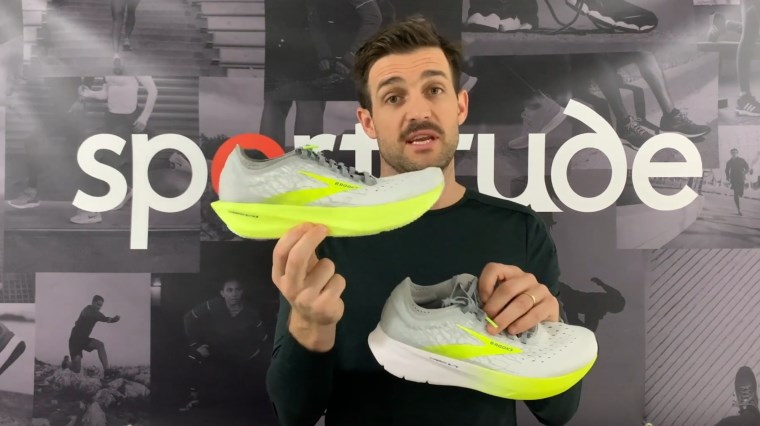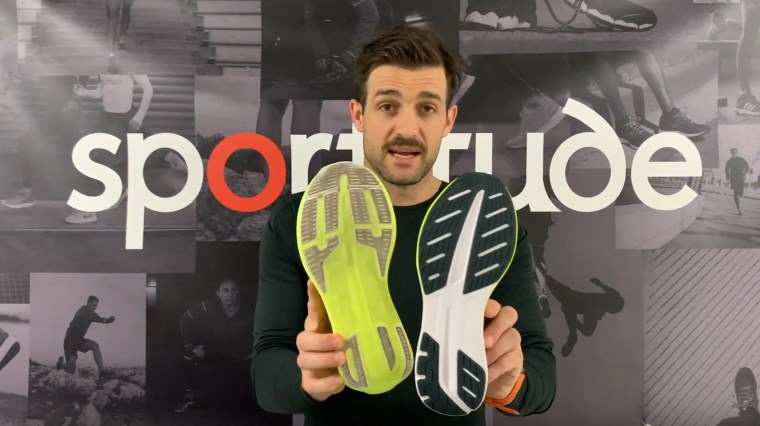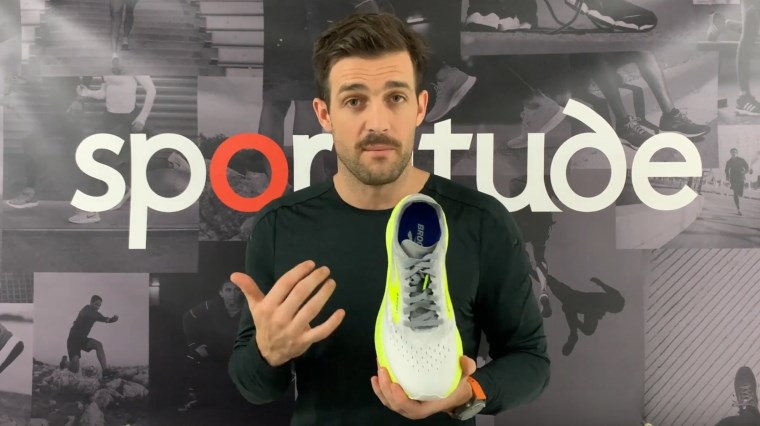Brooks Hyperion Elite 2 vs 1 Comparison Shoe Review

Josh reveals why he’s chosen the carbon-plated Brooks Hyperion Elite 2 as his go-to race day shoe for summer and highlights the engineering features that make it a top contender for everything from 10km events to marathon, to the occasional tempo session.
A minimalist, competition-ready outsole with exposed midsole and strategic zones of rubber at the forefoot and heel keeps the weight of your racing shoe low and your running experience fast.
This newest generation weighs in fractionally heavier than its predecessor, but it’s a worthwhile trade. The DNA Flash midsole ensures a responsive feel and just-right softness capable of clocking dramatically more mileage than the previous DNA Zero midsole.
It offers firmer density cushioning than competing racing shoes on the market – so even as you shift down a gear, you feel stable.
The featherlight and breathable stretch woven mesh upper of the previous model has been transferred over to this latest edition. It features a thin tongue and flat laces for a secure, race-worthy lockdown to chase down your next PB.
Check out the review with full transcript below.
Hi guys, Josh here from Sportitude Running and today it's shoe review time. We’re going to be talking all things Brooks Hyperion Elite 2. It has had quite the update from the version 1. There’s a lot to like about this shoe.
I have my pair in my hands and they’re nice and dirty - I’ve been through a couple of runs in these. So far so good, I’m loving what this shoe is doing for me. In today’s review we’re going to talk about all the engineering aspects of the outsole, midsole and upper.
We’re going to talk about the comparison from the version 1 to the version 2 and give you some information at home that may make this your next race day shoe. Without further ado, let’s get stuck in.
Runner Profile
First things first, what we like to do in our reviews is touch on the foot type that could be considering this shoe. It is a race day shoe. With race day shoes, they are lighter weight. To make them lightweight, brands take elements out to achieve that outcome.
We tend to find with race day shoes that there is no additional support system thrown into the shoe itself. If you happen to be a severe overpronator, don’t expect a race day shoe to have arch support on the medial side. The Hyperion Elite is no different.
Generally speaking a race day shoe is going to be neutral in design. If you are a runner that mildly overpronates and you’re looking for a race day shoe, this is going to be OK.
If you haven’t tried a lighter weight race day shoe my suggestion is to get yourself into a lighter, maybe more of a tempo style shoe. See how you go with taking a little bit of support out before you make a big plunge and put yourself into a lighter grade race day shoe. With that in mind, lets dive into all the changes with this shoe.
Outsole

First things first, we’ll touch on the outsole. Straightaway if I hold the Brooks Hyperion Elite 2 and Hyperion Elite 1 side by side you can see they’ve used a different material for their rubber on the bottom and they’ve slightly changed the positioning of that rubber.
That’s probably not the biggest change. The biggest change for me would be the amount of surface area they have for the v2. You actually have a lot more shoe underneath your foot. The surface area through the forefoot is a little bit wider and a touch wider through the heel and midfoot as well.
Brooks have placed rubber in the high impact areas. If you happen to be a heel striker, there’s a little bit of rubber placed at the heel at the first point of contact with the ground on the lateral side.
As you’re coming up through the forefoot and the midfoot region, you can see in the midfoot there’s an element of protection for the midfoot striker. For the forefoot runner, you have plenty of outsole rubber underneath your foot to land and stabilise on that first point of contact with the ground.
With the outsole, it’s quite a minimalistic approach. There is not a lot of rubber on the bottom. Again, it is a race day shoe and brands don’t want to add to much weight if they don’t need to. It’s a bit like last year's model, however there is a little bit more rubber underneath the foot with that shoe. The reason being from v1 to v2 is all about the midsole.
The biggest change in the v2 is the introduction of DNA Flash technology which is essentially Brook’s patented technology. It’s nitrogen-infused EVA which is a combination of plenty of cushioning and a explosive or responsive feel underneath your foot.
It is not the first time they have rolled this technology out. The Brooks Hyperion Tempo, the tempo concept shoe which they launched around the same time as the version 1 Hyperion Elite also has the DNA Flash, as well as the Brooks Catamount trail shoe they dropped into the market in recent months for that lightweight race day trail shoe.
With this in mind the DNA Flash technology has a little bit more durability to it. It was quite well document that last year’s model wasn’t designed for many miles at all. There was a lot of debate on how long they should or shouldn’t last. I put about 100km into mine and they were still pretty good. They were probably on the backend of their life with maybe about a third to go.
However, I’m almost certain we’re going to double if not triple the life of the midsole with the DNA Flash technology in the Brooks Hyperion Elite 2. That’s just my early day predictions and from other feedback I’ve had on this running shoe.
However, the reason there’s not as much outsole on the v2 versus the v1 is because the v1 was a DNA Zero midsole technology. That was a very lightweight EVA foam and essentially how they got it light was by pumping it full of a lot of oxygen. Really, what they needed to do was get a lot more coverage underneath the shoe itself with a bit more outsole to protect the DNA Zero midsole as much as they possibly could.
If you went with the Brooks Hyperion Elite 2 outsole on the Brooks Hyperion Elite 1 midsole I would be very surprised if that lasts as long as a marathon. They would have worn out really quickly. That’s why there was more outsole on the bottom of the v1 versus the v2.
Midsole

Now jumping to the midsole. The shoe itself being DNA Flash is on a higher stack. They’ve increased the height off the ground from the v1 by 2mm. We’re talking 35mm in the heel, dropping down to 27mm in the forefoot. That is a heel-to-toe drop of 8mm. It’s the same heel-to-toe drop in v1 with an 8mm offset. There’s a little bit more increase in the midsole off the ground.
With that DNA Flash, the Brooks Hyperion Elite 2 is a little bit higher off the ground. It has a slightly heavier material underneath the foot but it’s a great tradeoff because increasing the weight isn’t really a positive on the market.
When a brand of a shoe increases it’s weight marginally, it’s usually frowned upon. However, it’s a wicked tradeoff for this shoe. The way this performs underneath the foot is chalk and cheese in comparison to the v1.
The original Brooks Hyperion Elite had more of a traditional racing flat feel to it with a full-length carbon plate. However, for the runner that didn’t like that combination of softness underneath the foot which is where carbon shoes are trending at the moment with the Nike Vaporfly, Nike Alphafly, Saucony Endorphin Pro and the New Balance FuelCell RC Elite, the Brooks Hyperion Elite 1 had a slightly more firmer feel underneath the foot. There were runners out there that we saw in Sportitude Running and supplied out there in the market that enjoyed what this shoe did for them.
However, the Brooks Hyperion Elite 2 is coming into that market with that high demand combination of a bit of softness underneath the foot and also that explosive feeling with the full-length carbon plate.
While we’re talking about the midsole, Brooks have their RapidRoll technology which is essentially their version of a rocker through that forefoot. That’s purely and simply to make that carbon plate work in unison with your foot. It doesn’t matter if you’re landing on your heel, midfoot or forefoot, that RapidRoll gives you a nice, smooth transition as you go through to the end of your gait cycle.
Upper

Let’s get talking about the upper. This won’t take too long because the upper is exactly the same as v1. The great news is when you get something right, keep it, don’t change it. Brooks have done the same thing with v2.
The shoe itself is a stretchy, engineered mesh on top. Being a race day shoe, it is a minimalist take on an upper. You have a nice, lightweight and very breathable upper on your foot. Around the back of your heel counter there is an element of support, but not a huge amount on offer. There is no internal heel counter structure, but again that’s in line with race day shoes like the Saucony Endorphin Pro, Nike Vaporfly and Nike Alphafly. All of those shoes have a minimalist approach to the heel counter support at the back.
However, on the inside of this heel counter in the heel collar, there is a nice little lining of memory foam. When you step your foot into this shoe, you get a nice combination of comfort and plushness around the back of your heel which is a good touch from Brooks so well done there.
As you come through to the forefoot, as I touched on it is a very lightweight upper. The tongue is incredibly thin. For a lot of runners it can be something you get used to if you haven’t had a thin tongue.
However, with this flat lacing system I found this fit to be really nice. I like what the tongue is doing and the thin laces. Feedback from the v1 from some runners was they didn’t like the thin laces. As long as you get a good lockdown with the lacing system, you’re going to be absolutely fine.
Coming through to the forefoot, there’s a little bit more wriggle room on offer in comparison to other models out there I have used like the Saucony Endorphin Pro and the Nike Vaporfly. I found this shoe to be marginally wider through that forefoot.
To give you a little bit of transparency on sizing, I am a size 9.5 in the Brooks Hyperion Elite, Brooks Ghost and Brooks Adrenaline. In all of them I’m a D width as well, just to give you a bit of an idea of how this shoe fits for me personally. I found the 9.5 to be an absolutely perfect fit.
Before we wrap up this shoe review I want to give you my subjective opinion on the versatility of this shoe. It is a race day shoe - that is how it’s made, that is how it’s marketed. Brooks are coming at that with the DNA Flash carbon plate midsole. It is their race day shoe.
However, for the two runs I went in this shoe I did one at 5km at race pace and a couple of days ago I did an interval run that was 2 minutes 30 seconds on and 1 minute off inside this shoe.
I loved how it felt on my tempo run. I felt stable, light and explosive. I just loved what this shoe did underneath my foot, so much so that this will be my 10km and half marathon race shoe over summer and I would throw it into a couple of triathlons as well. I am really amped to get this guy out on race day, it’s going to be fantastic.
However, when I did that interval run I just felt confident enough after my tempo set that I could give this a go. Traditionally speaking when I’ve used a Nike Vaporfly, Saucony Endorphin Pro or even the New Balance FuelCell RC Elite for testing purposes to see how it went for my intervals, I didn’t feel the stability I like when I do an interval set. When I slowed down my pace and you have increased ground contact time, I felt a bit wobbly underneath the foot.
It is simply due to the fact that they are softer foams than what the DNA Flash is. Therefore, when you up the pace you feel really fast in the VaporFly, the Endorphin and RC Elite. However, with the Brooks Hyperion Elite 2, I felt just as fast when I was at race pace, but I felt incredibly stable when I had to drop back a gear and turn the legs over in my interval runs.
I’d probably put that down to the DNA Flash being a slightly denser midsole, and also the purchase area underneath the foot. You have a lot of real estate on offer so you get that element of stability as well which I think is fantastic.
This won’t be sold to the majority of people as a shoe you’d use in an interval set. However, if you’re looking to buy a race shoe and you’re thinking about buying it, I’d certainly highly recommend it.
However, sometimes it’s worth getting yourself used to a shoe and if it’s a tempo run at race pace, if it’s a race simulation training session you’re doing, or you want to throw it in for an interval session I reckon this could certainly be worth it. The mileage is going to be there. Brooks have said this shoe will get more mileage than the v1, almost double to triple that from the original shoe which is fantastic.
There you have it, that is my take on the Brooks Hyperion Elite 2. As I said, I love this shoe. This is my race day shoe. This is going to be what I’m getting out and about in this summer. I am really looking forward to tying them up and chasing a couple of PBs over the next few months.
If you have any questions, queries or comments on this shoe, if you’ve tried it on and you have some feedback please contact our Sportitude shoe experts. We love to hear what you all have to say and think about this shoe and other shoes too.
Please subscribe to the Sportitude YouTube channel if you haven’t done so already and we’ll keep you up to date and informed in all new running shoes coming in the months and years ahead.
Until next time, stay safe, be kind to each other and we’ll see you down the road. Take care.
FEATURES
Brooks Hyperion Elite 2
- Support: Neutral, Lightweight
- Upper: Mesh
- Midsole: DNA Flash
- Heel Height: 35mm
- Forefoot Height: 27mm
- Offset / Drop: 8mm
- Weight: 215g / 7.6oz
Brooks Hyperion Elite 1
- Support: Neutral, Lightweight
- Upper: Mesh
- Midsole: DNA Zero
- Heel Height: 33mm
- Forefoot Height: 25mm
- Offset / Drop: 8mm
- Weight: 195g / 6.9oz
